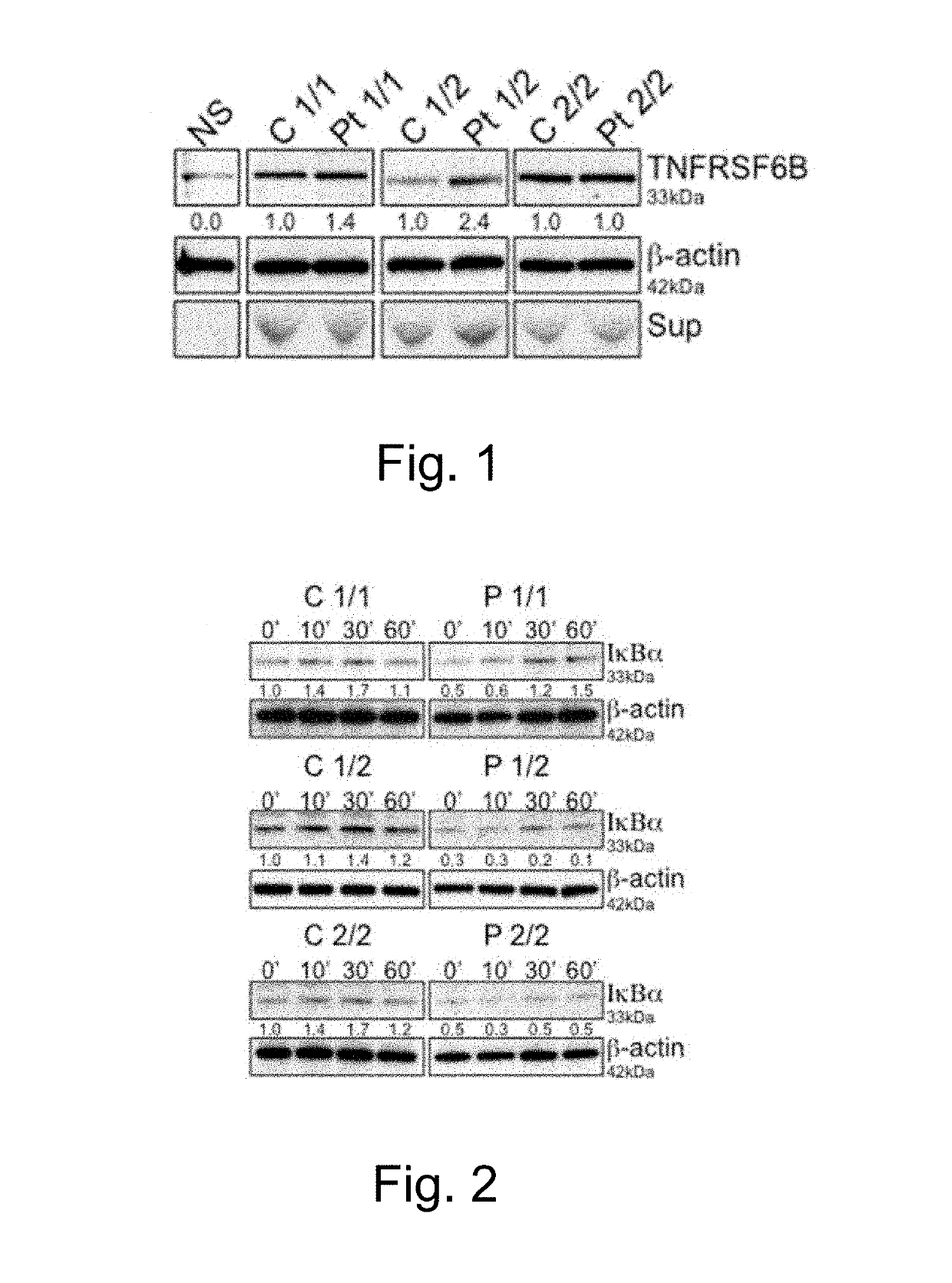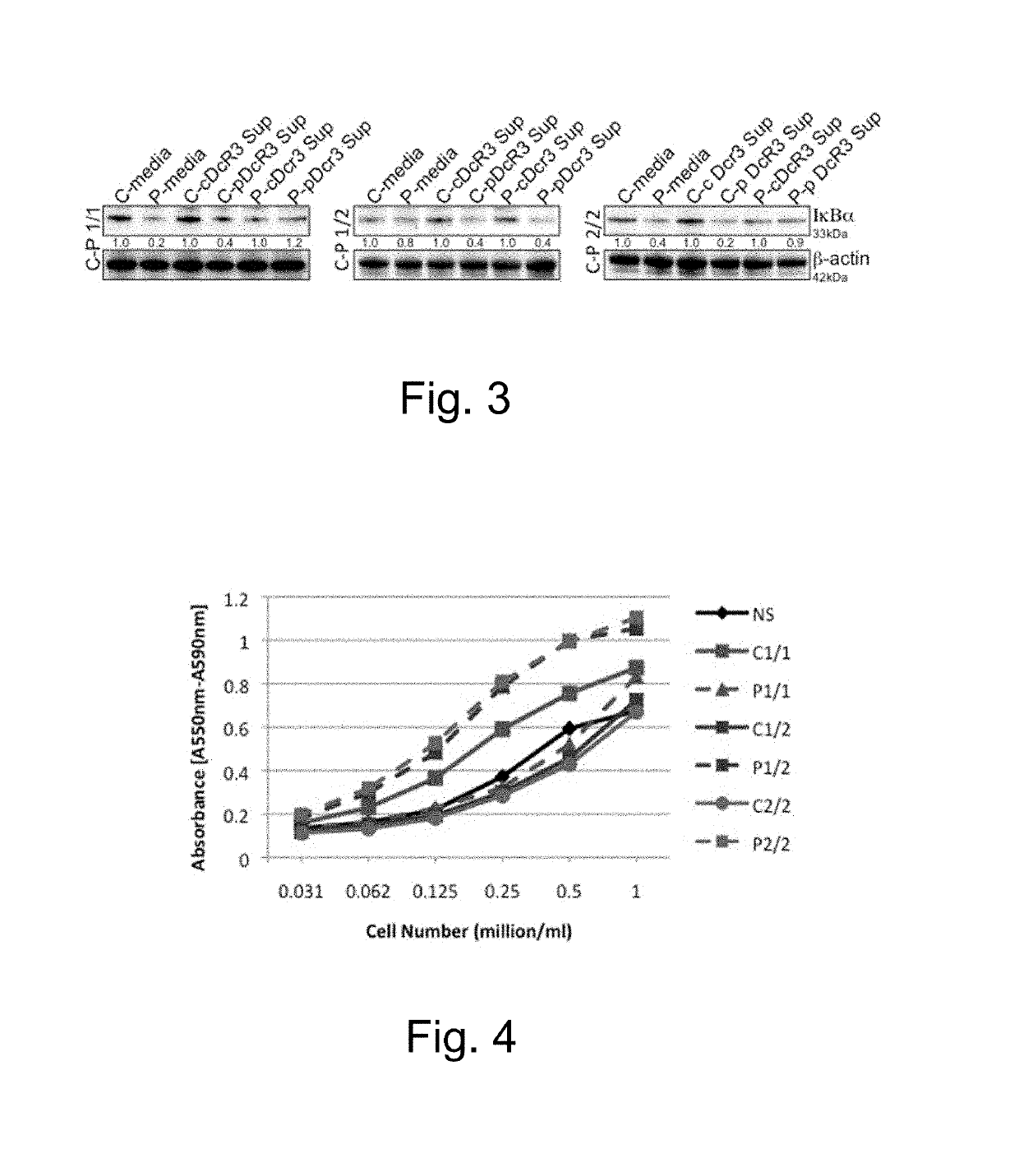Methods of treating autoimmune conditions in patients with genetic variations in DcR3 or in a DcR3 network gene
a technology of dcr3 and network gene, which is applied in the direction of immunology, metabolism disorder, drug composition, etc., can solve the problems of unopposed inflammatory signals and the less effective downregulation of dcr3 ligands, and achieve the effect of increasing t cell activity and increasing the production of ifn-gamma
- Summary
- Abstract
- Description
- Claims
- Application Information
AI Technical Summary
Benefits of technology
Problems solved by technology
Method used
Image
Examples
example i
[0189]To better characterize the role of DcR3 variants in IBD, we sequenced the exons of TNFRSF6B in a large number of Caucasian pediatric IBD cases and healthy controls. We uncovered several missense variants at the TNFRSF6B locus, affecting secretion of DcR3 from cultured cells that were significantly enriched in the IBD cases. Since these cytokines are pro-inflammatory, deficiency of DcR3 expression, secretion, or ligand-binding leads to unopposed inflammatory signals and exacerbation of IBD and suggests that DcR3 harboring such variation may be less effective in down-regulating ligands that provoke inflammation in the IBD cases. Thus, DCR3 has multiple complex roles within the innate and adaptive immune system, which may result in a net pro- or anti-inflammatory effect based upon the precise context and further modified by specific sequence variants (Refs. 7, 8).
[0190]The role of NF-κB in the pathogenesis of IBD has been examined in recent studies. Colon biopsies from IBD patien...
example ii
GWAS Study Data Concerning TNFRSF6B Genetic Alterations and Several Pediatric Autoimmune Diseases
[0224]A link between genetic alteration in TNFRSF6B and inflammatory bowel disease (IBD) was initially found as part of a genome-wide association study (GWAS) conducted at the Children's Hospital of Philadelphia (CHOP). (See WO 2009 / 105590.) Correlations between TL1A (TNFSF15) genetic alterations and IBD were also observed in that study. A further GWAS analysis has now identified a link between genetic alteration in TNFRSF6B and further autoimmune diseases (AIDs) such as multiple sclerosis (MS), thryroiditis, and psoriasis. An aim of that further study was to identify genetic alterations genome-wide that correlate to incidence of AIDs in pediatric subjects (pAIDs).
[0225]The study was performed on a combined cohort of over 6035 pediatric cases across 10 clinically distinct pAIDs and 10718 population-based control subjects. Whole chromosome phasing was performed and the 1000 Genomes Projec...
example iii
Identification of Further DCR3 Network Genetic Alterations in IBD Subjects
[0228]Further GWAS data in pediatric IBD sufferers has also revealed genetic alterations (specifically, SNPs) in several DcR3 network genes that are enriched at least 2-fold in IBD cases compared to controls.
[0229]The following provides a table of such SNPs:
[0230]
FreqFunc.SNPCHRBPA1casesA2CategoryGeneFunctionrsID1:652559216525592T0.02CexonicTNFRSF25nonsynonymous_SNVrs357713716:31540556631540556C0.308TexonicLTAnonsynonymous_SNVrs22290946:31540757631540757C0.072AexonicLTAnonsynonymous_SNVrs22290926:31544562631544562T0.004CexonicTNFnonsynonymous_SNVrs46458436:31549357631549357A0.004GexonicLTBnonsynonymous_SNVrs46471876:31549407631549407T0.004CexonicLTBnonsynonymous_SNVrs309355410:907686761090768676T0.008CexonicFASnonsynonymous_SNVrs321861410:907717671090771767A0.004GexonicFASnonsynonymous_SNVrs5600612819:6665020196665020T0.048CexonicTNFSF14nonsynonymous_SNVrs34456019:6670070196670070A0.004CexonicTNFSF14nonsynonym...
PUM
| Property | Measurement | Unit |
|---|---|---|
| temperature | aaaaa | aaaaa |
| Tm | aaaaa | aaaaa |
| pH | aaaaa | aaaaa |
Abstract
Description
Claims
Application Information
 Login to View More
Login to View More - R&D
- Intellectual Property
- Life Sciences
- Materials
- Tech Scout
- Unparalleled Data Quality
- Higher Quality Content
- 60% Fewer Hallucinations
Browse by: Latest US Patents, China's latest patents, Technical Efficacy Thesaurus, Application Domain, Technology Topic, Popular Technical Reports.
© 2025 PatSnap. All rights reserved.Legal|Privacy policy|Modern Slavery Act Transparency Statement|Sitemap|About US| Contact US: help@patsnap.com



